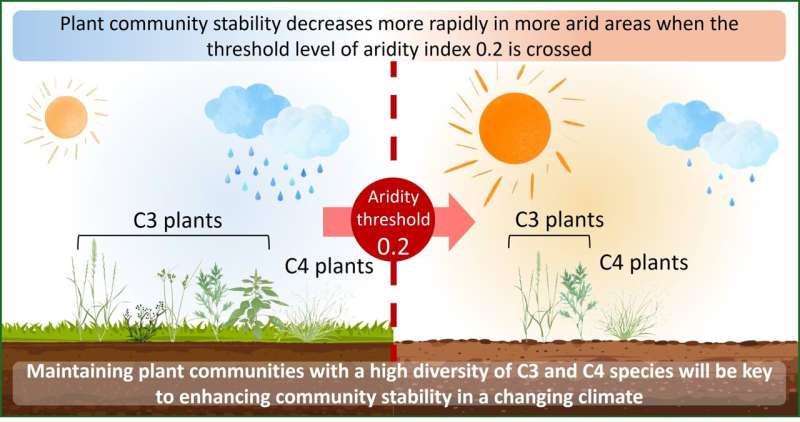This article has been reviewed according to Science X's editorial process and policies. Editors have highlighted the following attributes while ensuring the content's credibility:
fact-checked
peer-reviewed publication
trusted source
proofread
Mongolian grasslands study reveals key drivers of plant community stability in changing climate

An international research team has undertaken a study of plants in the Mongolian grasslands to evaluate the stability of these plant communities over time. They specifically looked at how the dryness of the climate impacted the plant communities and determined that the stability of the plant communities decreased more rapidly in more arid areas. This research helps in the development of effective management strategies that promote stable ecosystems in a time of changing climate.
The research is published in the journal Global Change Biology.
Scientists know that climate change affects the way biodiversity influences the stability of plant communities. A stable, healthy ecosystem will provide food and forage production, carbon sequestration, and soil formation. Theories predict that higher biodiversity and lower species synchrony can increase a community's stability. Species synchrony describes how the abundance of species varies simultaneously over time. The decreased abundance of certain species is compensated for by increases in others, thereby maintaining constant productivity at the ecosystem level.
Also, plant species stability (the average stability of all species weighted by the abundance of species in a community, largely representing the stability of dominant species) may enhance community stability. Detecting critical drivers of ecosystem stability provides ecosystem managers with a tool for increasing ecosystem stability by managing diversity and the relative abundance of certain plant species.
The team undertook their study using an eight-year dataset from 687 sites in Mongolia. They evaluated whether the temporal stability—which is quantified as the ratio of temporal mean to standard deviation—of the plant community cover changed linearly or nonlinearly along the aridity index gradient, ranging from a hyper-arid 0.03 to a dry-subhumid 0.58. Temporal stability describes how ecosystems remain in the same state over time in response to environmental changes or human impact.
"We then disentangled the effects of species richness, community-wide species synchrony, average stability of all species, and the synchrony between C3 and C4 species on the temporal community stability along the aridity gradient," said Professor Takehiro Sasaki, Faculty of Environment and Information Sciences, Yokohama National University.
In C3 plants, such as rice, oats, barley, wheat, soybeans, cotton, and peanuts, the first carbon compound produced during photosynthesis has three carbon atoms. C4 plants, such as corn, switchgrass, or sugarcane, produce a four-carbon compound during photosynthesis. Most plants on Earth are C3 plants.

The team learned that the temporal stability of plant communities decreased more rapidly in more arid areas when the threshold level of aridity index 0.2 is crossed.
"Species synchrony can be a primary driver of community stability, which is consistently negatively affected by species richness while being positively affected by the synchrony between C3 and C4 species across the aridity gradient. Maintaining plant communities with a high diversity of C3 and C4 species will be key to enhancing community stability across Mongolian grasslands in a changing climate," said Sasaki.
The team's work provides a comprehensive understanding of the relative importance of drivers for plant community stability and advanced their knowledge of stability mechanisms.
"The key drivers of plant community stability that we found in this study should be considered when developing effective management strategies to ensure the provision of stable ecosystem services essential for human well-being in a changing climate," said Sasaki.
Looking ahead, the team suggests that future studies should evaluate how livestock grazing induces biodiversity changes and affects plant community stability across a wide range of climate variations. Grazing is the main way that the land is used in drylands and can interact with climate and biodiversity, having an impact on how the ecosystem functions.
"Our ultimate goal is to provide efficient management tools for sustainable use of drylands under the influences of multiple global change drivers," said Sasaki.
More information: Aridity-dependent shifts in biodiversity–stability relationships but not in underlying mechanisms, Global Change Biology (2024). DOI: 10.1111/GCB.17365
Journal information: Global Change Biology
Provided by Yokohama National University




















